Review GSM phone Nokia 5140i

Nokia 5140i. Live pictures
Package:
- Handset
- Charger
- Manual
- Headset
- Hand strap
- Carbine
Traditionally "i"-indexed models do not bring any great number of differences from the original device, and the Nokia
5140i proves the rule. This device belongs to the sport category or as the company classifies to the Outdoor, Active segment.
The model is 3G in this segment, and Nokia 5100,
Nokia 5210, Nokia
5140 were its predecessors. It's important to stress the Nokia
5140i shouldn't be considered as the one excelling the Nokia 5140, the differences are minimal and as for the body there they are absent at all. The main difference is 65K display; the previous model has a 4096 STN one. The delivery kit got richer, the version of the 40th platform is newer, which caused new menu icons and slight functionality changes. In fact the model has not changed, the device remained the same. This phone is interesting as the second one for active sport like mountain skiing, but it looks rather dull as the main one, since it lacks many today functions (starting with mp3 and ending with Bluetooth). Last year comparing Nokia 5140 and Siemens M65 made some sense; these models belong to the same class and have equal possibilities. The Nokia model lost but got points due to many accessories. This year the Nokia 5140i looses to the upcoming Siemens M75, since these models are of different classes and capabilities. And even extra accessories do not make up the entire technical gap between the models. It seems the 5140i was created for a small customer niche. Though even the Nokia 5140's sales showed there is no great demand for such phones, the target group is small.
The renewed screen is 128x128 pixels (28x28 mm), and a protective glass is a bit toned. Good quality of the picture is not provided even in spite of the 65K supported. The model looses to modern devices considerably in this parameter. Two factors tell upon - the first one is the screen's physical size, and the second is its resolution. Both values are minimal. But that was excusable considering the phones positioning for use in extreme conditions, the explanation was in the phones' better protection (as we all know the screen is the most fragile part of the phone). However the screen behaves awfully in the sun, the picture is not seen, and not the last role here belongs to the protective glass toning. Due to the use of various substrates fonts are also hard to read, though you can select the font-colour for the standby mode.

The dimensions equal to the previous phone's ones (106.5x46.8x23.8 mm), the weight is 101 grams. Unlike the Nokia 5140 the device is provided in two colours.


The phone's design stresses its protected entity, flows of rubberized plastic on side surfaces, a catch closing an interface slot, a lining above the battery. These altogether makes a feeling the phone is protected from any disaster. Certainly, the protection level is much higher as compared with usual devices. However we recommend not throwing the phone against the wall or through the window on purpose. It may not bear such treatment. Throwing it into a bucket with water means saying good bye to the phone voluntarily. Since the device is pseudoprotected, that means it is not for too active use in aggressive conditions. There are too little of these phones and a serial model for them was the Nokia 6250. Though many users find this protection level quite enough and similar models are bought for summer hikes and outings, mountain skiing or any other entertainments.


On the front panel you can see a small white round gap, which is a level. Having put the device on the table, for instance, you can see if it is put horizontally. The presence of the level is dictated by the electronic compass built into the phone. This function is to devote a special talk to, and we'll speak about it later.

Traditionally, the phone is equipped with a lamp; it is placed on the top, pressing the # key you can activate it. The lamp doesn't work with the keypad locked, why that is so remains unclear, you have to unlock the keypad first. An on/off button is placed on the top also, fast switching of profiles in the standby mode is possible with its help. The button is deeply sunk into the body, and pressing it is rather hard.

The body completely copies the Nokia 5140, only foam-rubber insertions on side surfaces appeared, they provide additional panel fixation. The buttons have no big gaps, that is due to the construction. On the one hand that prevents the inner part of the phone from moisture, on the other hand - it makes put some effort for pressure. Side volume buttons are a bit tight like the PTT one to the right. This should be treated as the body's construction peculiarity. The keypad is backlit with separate LEDs, placed on both sides of the very buttons. Characters are well seen on the number keypad almost in all conditions.



If you want to open the body, press on two hollows placed on both sides and pull with power. The basic block is relatively waterproof, subjectively, the joint level is not ideal. That is mainly connected with the absence of bursting open springs, unlike the Nokia 5100, here they are replaced with plastic (a cheaper solution, but less protection when hit and from moisture).

The keypad is removable and may be taken off as a single block. The keys of the first two horizontal lines are comfortable, lower rows are not as good. The same about the navi pad. On the one hand it is comfortable due to its disposition and size, on the other hand - fingers get tired of pressing the rubber. Considering the classical character of the keypad it may be called average in comfort. Neither evident pluses no many disadvantages. According to Nokia 5140 users, the navi pad is not comfortable for everyone, some of the users show total unreceptiveness of the button.


The battery is closed with a plastic insertion, you should pull a tag to take it off. The Nokia 5140i uses the BL-5B battery, it is 760 mAh Li-Ion. The manufacturer claims the phone can work for from 150 hours to 300 in the standby mode and from 2.5 to 5 hours in the talk mode. With all the possibilities used, calls up to 60 seconds in duration and even 30 minutes of using other functions, the device worked for 4 days (Moscow, MTS network). And ordinary users could keep the device working for from 3 to 5 days.

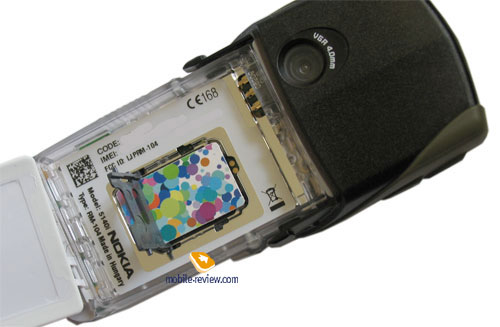
A VGA-camera gap may be seen on the back of the phone. It is typical of other Nokia devices. When a strap is on the phone, the camera is always closed, so you won't be able to take photos quickly. The hand strap is made of silicon and can serve as a waist belt. The phone looks badly on a hand, since it is placed perpendicular to it. The strap is little for a big hand, it pinches the arm on the last point.

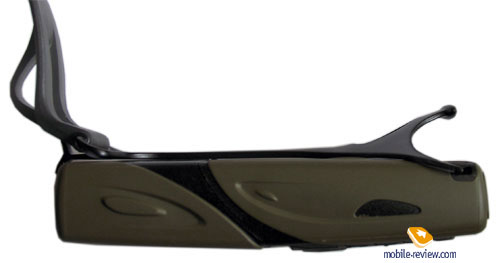
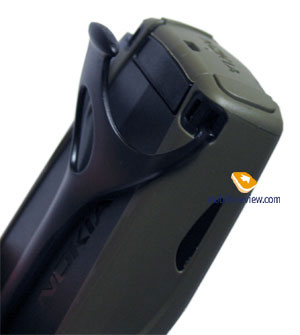

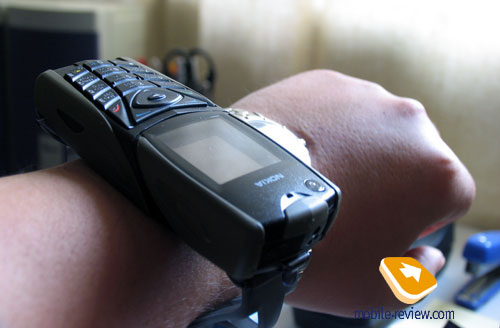
Plastic fastening makes no troubles; it is reliable and is unlikely to break from light load. We tried to tear the phone away from the waist fastening, and it remained there even at sharp jerks.
Also the kit includes a carbine with an integrated magnifier and a whistle. The carbine is of plastic and doesn't look very steady. In general the device may be attached both to clothes or your bag. It has everything necessary for that.

A positive innovation is a stereo headset that allows listening to the radio. It is connected via a standard Pop-Port connector, a shutter naturally opens, which decreases the phone's waterproof features. Earphones construction is comfortable; the loudspeakers are closed with silicone bungs. A call answer button and a microphone are placed on the controller. The headset is really pleasant at work.
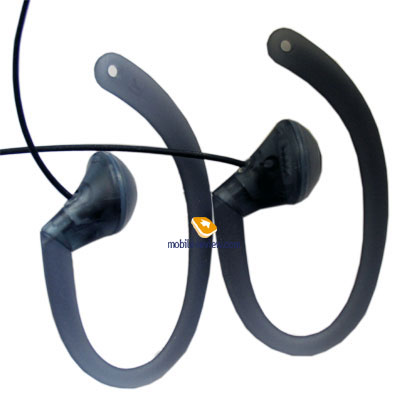



Menu
The model is based on the same software version as the Nokia 6230i. Thus, here you can select font-colour in the standby mode, there are some other improvements, for instance, a user icon is shown at outgoing call. A separate folder in a Gallery is provided for all the received files. The main menu has animated icons similar to the Nokia 6230i, Nokia 8800. And the icons look badly due to the low screen resolution.
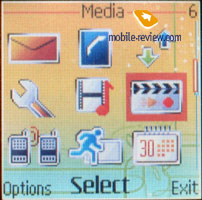

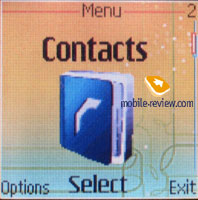

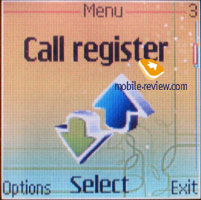
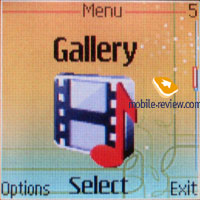
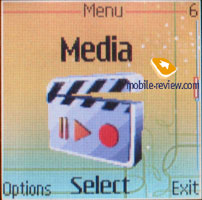
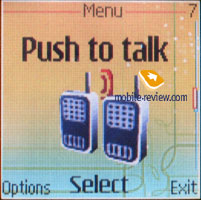

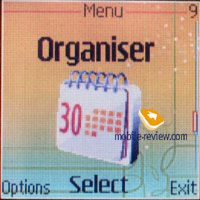

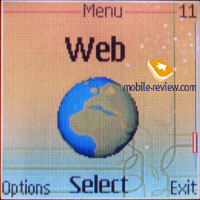

Pressing the navi pad calls the menu with rows of icons in the main one. Up to 9 icons are displayed on the screen at once and if there are more of them (for instance, SIM-menu) you can use a scroll bar and scroll the screen down. The second menu type is classical with an icon of the selected menu and it name.
A digital clock-like screensaver appear on the screen in the standby mode, small icons of missed calls are shown as well, that is an advantage of the phone.
Joystick deviations to various directions are responsible for a fast call of this or that function, which makes dealing with the phone easier. Any function may be assigned to the right soft-key (select from the list), a list of the most frequently used menu items may be composed. Finally, about ten menu items may be bind voice marks, the device recognizes them well. Before discussing separate phone functions we should stop at memory distribution. There are 4 MB of internal memory.
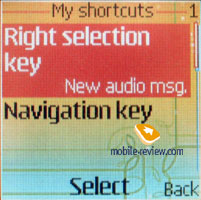

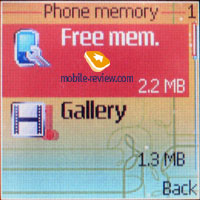
Phonebook. It is possible to keep up to 1000 names in the internal memory and it is the maximum number of entries. It is achievable if you enter not much information for a name, just one or two fields. And with medium filling that is 6-7 fields for a name you may keep about 500 entries but not more. As it have already become clear it is possible to enter up to 5 numbers for a name and choose a type of the number (primary, mobile, home, office, fax). The first entered number becomes a default one and may be changed later if you wish. When entering the number for the first time, you type in only a name and one main number; all the other things are committed later from the edit menu. One may consider this not very comfortable; one will on the contrary say that keeps only one number for a name. Both will be right. Considering that similar input is realized in all the phones by Nokia, we'll surely say that it makes no troubles.
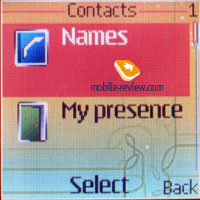 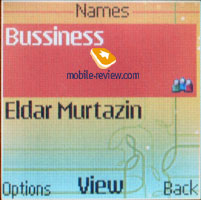
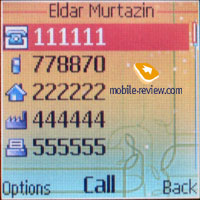 
E-mail address, site url, post address and text note may be set as extra information to a number. The one new function should be pointed out, that is USER ID and it is user indication for the presence service. In general it is like an ICQ and signals that this or that user from your list is present or not at the moment.
A photo may be added to a number (only portrait mode, changing the photo automatically to a corresponding size). When viewing the information on the name you won't see the photo automatically, you'll have to open a corresponding menu item for that. On the other hand, it is possible to set the view of a name and a corresponding image in the list. In that mode the icon is not large and doesn't give a good notion of the photo. Other modes of viewing the list are traditional - only names, names with the primary number. Numbers from both internal memory and SIM-card memory may be displayed in the main list. Up to 25 voice marks may be assigned to separate names.
 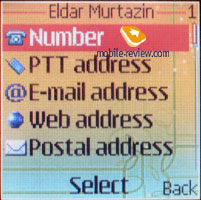

There is a possibility to assign up to 100 photos to names. During the incoming call the number and the photo of the caller are displayed. The picture is a bit larger than the one you see in the list but still smaller than it is necessary. You'll have to use your imagination to finally understand who is in the picture because a reduced photo has extra artifact. In general a photo takes a very small part of the screen and it is not explicable logically. At the moment realization of this function is the worst by Nokia among all the manufacturers and we hope that in future it will improve.
Up to 25 callers' groups may be created, they will be displayed in the generalist with usual names.
Messages. The phone supports Nokia Smart Messaging standard, this allows sending and receiving ring tones and simple black and white pictures from compatible phones. Besides Nokia phones this standard is also supported by Samsung, LG and some of the new Motorola phones. Especially for such messages 10 graphical templates can be spotted in the phone's memory.
 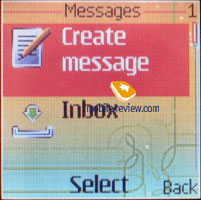
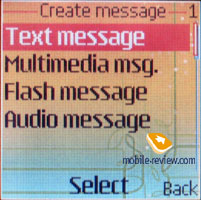 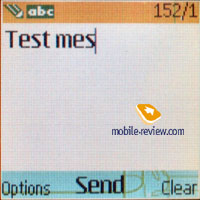
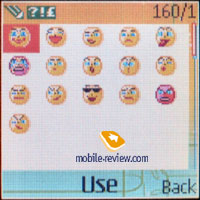 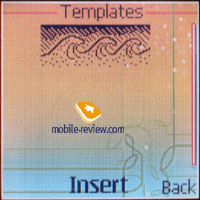
 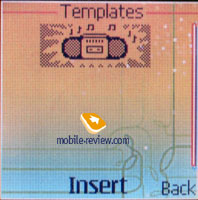
The company believes that MMS can be considered a full replacement for EMS. Well, it is true actually since this technology became popular rapidly, and with its help you can create interesting messages which include pictures, photos, and ring tones and so on. Each message can be up to 300 KB. The MMS functions are good and no problems were noticed.
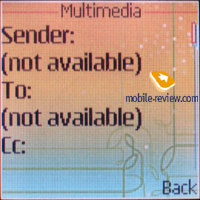
The phone has a built-in e-mail client that can work with POP3/SMTP/IMAP4 protocols. The possibilities of the client are incredibly poor, attachments are not supported and the device understands only one Russian coding.
There are mailing lists for usual messages, you can add users from the phone book to these lists, that is comfortable of you send similar messages to some of your friends or colleagues often. Traditionally templates are added, you can create personal folders or distribute received, sent messages among them.
Audio Message is a kind of MMS, but here you can only attach a dictaphone record not longer than 2 minutes 5 seconds primordially.

Call lists. There are three lists in the phone - received, dialed and missed. Every list may contain up to 20 entries, and conveniently the date and time of the call are displayed in the list. Pressing the Call button in the standby mode brings up the list of the last dialed numbers.
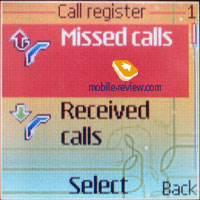 
Settings. Profiles may be activated from this menu or switched quickly by pressing the On/Off button. Every profile may be activated for a period of time and then the phone turns to the default profile. Sound alerts may be set for all the events, incoming calls, all the calls or special users' groups. Profiles in Nokia phones are some of the best on the market.
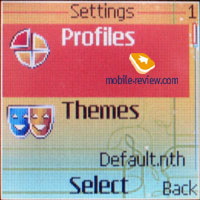 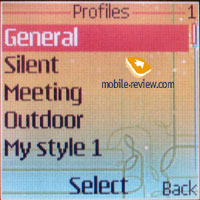
The screen settings allow choosing its color scheme, wallpaper and a screen saver. The screen saver is a picture that is displayed in the standby mode when the backlighting is not active. It is worth choosing one of the preset pictures, they are seen better in this mode than loaded full color images. You can set the time interval for the screen saver and then it will be replaced with standard digital clock.
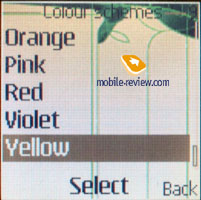 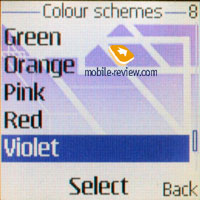
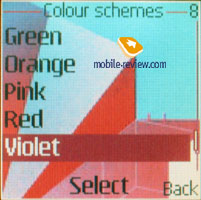 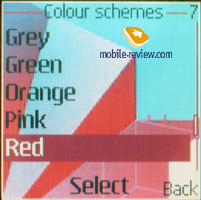
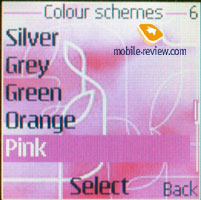 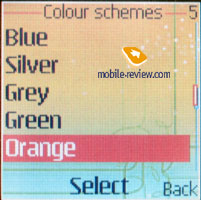
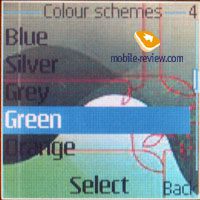 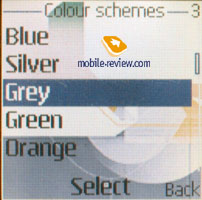
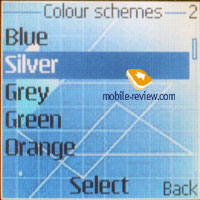 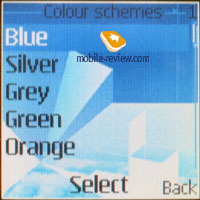
 
IrDA may be switched on from this menu, and batch communication settings are available.
Automatic volume control should be mentioned from other settings, the device chooses the level automatically depending on the surrounding conditions. You won't notice any great difference in the room, but outdoors the function may be useful.
The phone is empowered with the automatic key lock and you can also set a safety pin number so that nobody can use your phone. For the accessories purpose, there is now a possibility to set "a mood" of the phone, for example, to choose a profile that will be activated when the battery charger is on. This is an interesting feature. You can tune in the phone according to your wish and necessities.
Gallery. The folders with various files are stocked here, all of them having matching titles. You can view the folders as a list, as a list with names or as icons.

Media. All the settings concerned with the multimedia possibilities of the phone are kept here. Let us start with the Camera. The integrated camera allows you to take pictures with the VGA resolution and a portrait one ( 80x96 pixels). The picture quality on the screen is mediocre. After you send the pictures to the PC, they look better although you can still wish for the best. Camera settings are ascetic. There is a night mode, three types of file quality and compression. The files are stored as JPEG.
 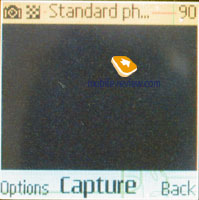
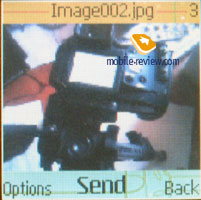 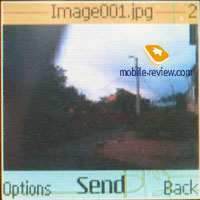
The video recorded is 15 second 3GP clips (128x96 pixels, with sound - AMR). You can't set the maximum clip duration unlike the other devices. The restriction is probably connected with little memory in the phone.
The clip quality on the phone screen is low, the sound seldom corresponds with the spoken words, and the picture is unclear and degraded due to the display. The clips also look very badly on a PC, and the function is more an entertainment that should be used in the phone, though anyway loosing its sense.
The Dictaphone has been increased to an hour and earlier it allowed recording up to 3 minutes at once. It records both sound and voices. The number of separate entries is limited with only free memory.
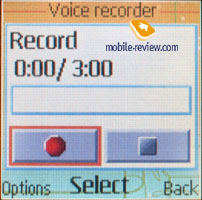
Radio. The device allows keeping about 20 FM radio stations with assigned text names. The function is similar to other phones by Nokia and pressing the button on the headset switches the stations. The radio can work in a speakerphone mode, but the headset is necessary, since it serves as an aerial. The radio signal can also serve as an alarm clock but still you need the headset plugged in.
 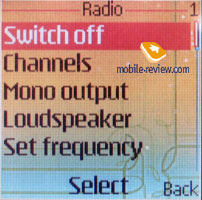
Organizer. You can enter from 100 to 250 entries depending on their length; old entries are automatically deleted (on the basis of the time period). The calendar can be viewed monthly or weekly with division for hours, fast switch to the selected date. Up to 5 various events are supported (meeting, call, birthday, memo, note), a reminder may be assigned to any event that may be also recurrent.
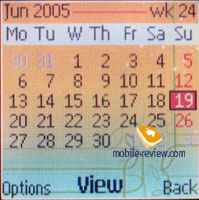 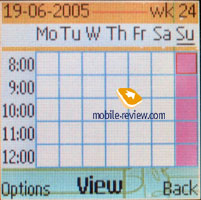
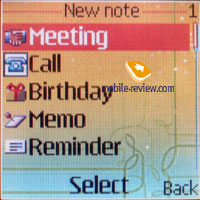 
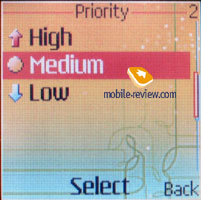 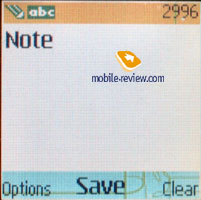
A to-do list allows keeping events with three types of priority (high, normal and low) and setting a critical date for the event.
Notes - each note may contain up to 3000 characters. That is more than enough even for the most demanding user. Two font-sizes are supported like in messages.
Electronic Wallet is the place where the most important information may be kept protected with a password. For instance, the data about your credit cards. On the other hand it won't be very difficult to get the information if you loose the phone and that is why you'd better keep only the most necessary things there.
An alarm clock allows to set both once or a recurrent alarm with the selection of weekdays.
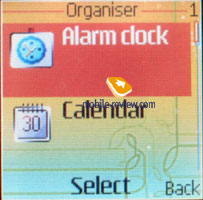 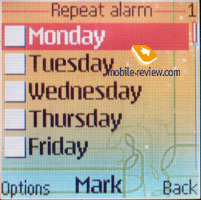

Sport. Here all the preinstalled Java applications are stored, as well as standard functions like a calculator, countdown timer, stopwatch (with intermediate values). There are two games in the phone. The first one, AdventureRace, is extreme bicycle riding, you may apply various tricks. The second one is a well known bowling.
 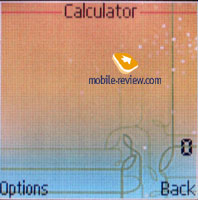
 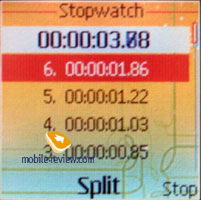
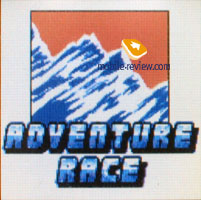 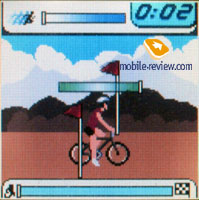
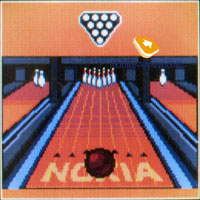 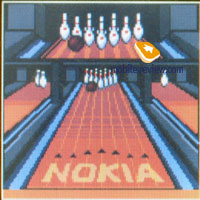
Compass. That is the first time a device is equipped with an electronic compass. To calibrate it you need to place the phone horizontally and turn it around. If you do that too slow or too fast, then calibrating will not be finished. Principally, calibrating the compass will be very hard in camp conditions, you'll need an even horizontal plane (and here is when the level turns necessary). Setting a deviation should be pointed of extra functions.
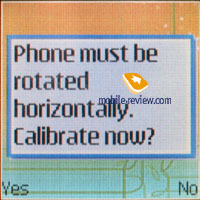 
Thermometer. So, following the name that is a thermometer measuring the surrounding air temperature. The error may form up to several degrees. If just turned on, it will need about 20 minutes to show real values on the screen. Generally, the temperature indicated is more true than false. It is possible to show temperature on the screen in the standby mode.
The last function is Sound meter. On selecting this menu item you can measure the sound level in decibel. The manufacturer specially stresses the function is not intended for professional use. This very function is used for adopting sound adjustment in various sound conditions. The function really works; the change of the sound in the loudspeaker is notable. It feels the volume rises several points in a noisy street.
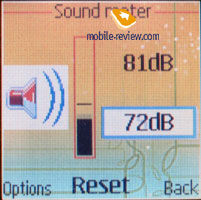
Fitness Coach allows planning your sport activities, make plans for them. That's pleasant you need to enter a password obligatory to work with the application, the developers considered it personal and not allowed to everybody. While loading a window tells the application guarantees no results, probably, some claims have roused among not very clever users lately.

Push To Talk (PTT). This technology is some kind of a walky-talky organized with an operator's support. Thus, on the one hand you need the operator's support, and if it's present, then you can switch the service on. The PTT button is on the right-side surface.
Services. The device supports batch communication class 10 (4+2, plus EDGE class 10), at the same time the wap-browser is 1.2.1 (supports xHTML , which makes it partly compatible to the 2 standard).
Extra accessories for the Nokia 5140i or a GPS-receiver
Unlike the Nokia 5100 the company refused issuing extra interchangeable panels, since they lacked consumer demand. But there is one unique accessory among others. That is a GPS receiver. The power is taken from the phone's battery (energy consumption from 30 to 85 mAh), that is an advantage in some kind, since no external power sources are necessary. On the other hand using the GPS receiver fully you'll have only a bit more than one day of battery life. Considering the GPS system works in any point of the world even there where you can't use a usual charger from electric mains, you can face a problem. From this point of view GPS receivers powered by usual finger batteries and similar in size and form storage ones are more interesting. But there is a chance you'll use disposable chargers (3 - recharges before complete discharge), their price is rather high, though there are no alternatives.

The receiver's cool start takes about 90 seconds. That is for the first switch on or after the device was turned off. Normal or warm start takes about 50 seconds, that is the case the receiver was not used for more than 2 hours, or a GPS application was off. Hot start takes 10 seconds, which is an ideal case.
The received data format is WGS84, positioning precision forms up to 25 meters in a horizontal line (12 channel receiver, integrated antenna). Up to 30 routes may be saved in the phone's memory; the maximum number of route points is 100. Generally they form typical possibilities of a low end GPS receiver. The application remembers routes, can return to the initial point, show transfer speed, the distance covered. The routes saved may be sent via SMS, which is rather interesting.

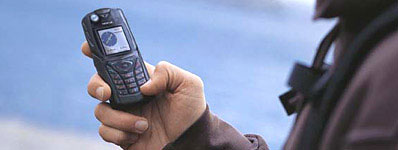
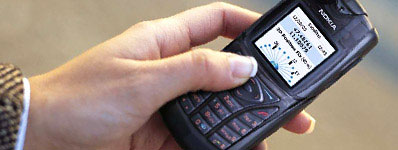

A user can receive the cards he needs through Travel Guide Service, a year subscription comes with GPS-Shell. There are cards for the majority of European countries, also extra services include searching for restaurants, museums, addresses.
Now none of the manufacturer has anything alike. Since having added this accessory to your phone you practically get a complete copy of Benefon ESC! (out of production already) with corresponding possibilities. The minus of the solution is a small screen that really behaves badly in the sun. That crosses any professional use of the device. At the same time, this solution is suitable for pseudo extreme tourism, week-end hiking. You can share your routes with another group of travelers (even not equipped with a similar phone, but having only a phone and a usual GPS receiver).
The price of the GPS panel will range from 150 to 180 USD depending on the country. In the absence of any rival products the price looks acceptable, but comparing the price with a usual GPS receiver, we see that is rather high. Now a half-professional receiver costs a bit more.
Polar watches for professionals and just rich Nokia 5140i users
A Finish company of Polar is one of the biggest manufacturer of cardiomonitors and various devices for sportsmen, in particular, palpitation, pressure, movement speed, load monitors. Among those very many Polar devices two are certainly of interest for Nokia 5140i users. They are Polar 625X, Polar 725 watches. Calling them watches is rather hard, since that is the plainest function of them. The first model is for those who go jogging. It measures movement speed, incline, load, palpitation, and an installed program allows selecting an optimal load level. Also there are optional sensors for the model, they allow extending standard capabilities. An IrDA is integrated into the device and it allows transferring training results to a PC or to the Nokia 5140i as you have already guessed (and then send wherever you like by SMS). The difference of the 725 model is that it is oriented on cyclists.
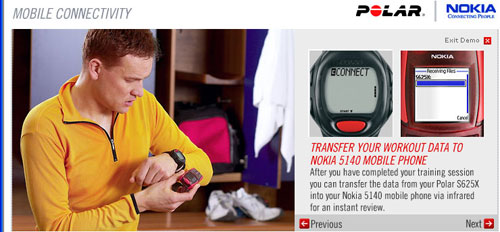
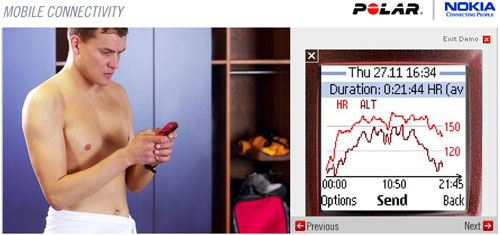
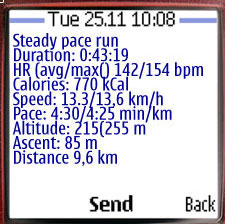
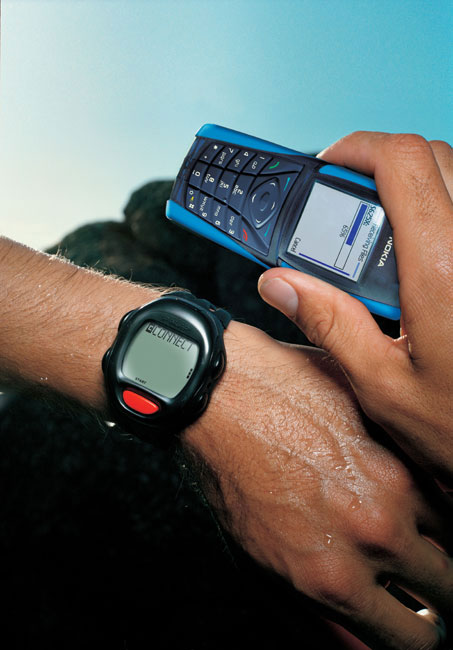
The phone screen shows a diagram of pressure and palpitation, also a summed up result of the training is provided. Using the phone you won't get such a wide set of possibilities for a good analysis of your training as the Polar software allows, also a special site helps finding training programs, getting consultation, saving personal achievements.
The Polar watches exceed everything present on the market now (I'm not a specialist in this field, but found no copies). The price for the device and the service is rather high. The younger model costs about 500 USD, and the elder one 550-600 USD. Considering the prices we can say the devices won't be very popular among amateur sportsmen, and they will find application among real professionals. And of course, among some young men that can allow such watches. The greatest market for these watches is present in Russia, but the watches are absent here. That makes some opportunities for those who will be the first ones.
Impressions
The Nokia 5140i is a typical 40th platform device in the connection quality, it has no problems. The power of its vibracall is average or even a bit weaker (weaker as compares with usual 40th platform devices). The volume of its polyphonic call signal is low, it may be often missed.
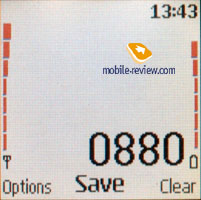 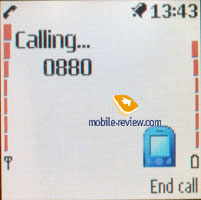
 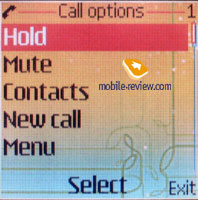
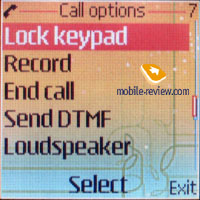 

The model doesn't look up-to-date as the main phone; this is a morally outdated device. It is appropriate as the second phone for extreme rest. If the Siemens M75 was absent on the market then we could say the solutions applied in the Nokia 5140i are well-taken. But the presence of this strong rival decreases the Nokia 5140i's chances; this is a niche solution for the brand worshipers. The July price will form 300 USD, which slightly differs from the price of the 6230. Functionally the models belong to different classes, and the elder one is more interesting. Protective functions are the one unique feature of the Nokia 5140i. I can't judge how demanded they will be against the background of the general low phone functionality and a bad screen. Unfortunately, the model is morally outdated even for the launch date.
Call melody samples (mp3, 190 KB)
Eldar Murtazin (eldar@mobile-review.com)
Translated by Maria Mitina (maria.mitina@mobile-review.com)
Published — 29 June 2005
Have something to add?! Write us... eldar@mobile-review.com
|






















































































































